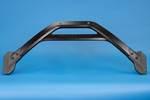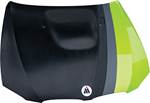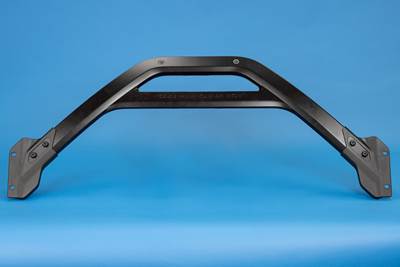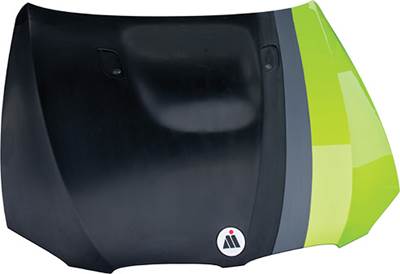PUR composite sandwich panels for 3D automotive parts, high-volume panels and more
At its U.S. sites, Ascorium produces glass fiber/PUR 3D parts via semi-automated molding, high-volume flat panels via a continuous line while working toward bio-based PUR and recycling.
Ascorium’s CompoLite products combine the company’s polyurethane (PUR) sandwiched between glass fiber or natural fiber, made either via a robot-assisted spray-up and compression molding process (such as the pictured 3D automotive trunk component) or a continuous compression molding line for 2D panels. Source (All Images) | Ascorium Industries
Ascorium Industries (Königswinter, Germany) was founded originally as a gunpowder manufacturing company in Belgium in 1778. Following industry needs, the company evolved over time into a polyurethane (PUR) manufacturer that is today headquartered in Germany with 12 sites across Europe, North America and China.
Ascorium currently has two main product divisions: It supplies its PUR systems as-is, in chemical form or as foam and also offers design, manufacturing and testing services for parts made from its PUR products.
The parts production division began first in Europe with manufacture of PUR insulation plates for the construction market. In the U.S., Ascorium’s parts production is mostly focused on automotive interior components like instrument panels, glove boxes and truck bed covers. These are manufactured at its parts production facility in Tuscaloosa, Alabama, from PUR made at its chemical production facility in Auburn Hills, Michigan.
Over the years, Ascorium has perfected its continuous processing lines for production of PUR components, and in the past 6 years has begun expanding this materials and process know-how to include composite sandwich panels that combine PUR foam with glass fiber reinforcement.
CompoLite and 3D parts process
Introduced in 2018, the CompoLite product, at its most basic, is a sandwich panel comprising a spacer made from PUR foam between two nonwoven fabric skins that are typically glass fiber. Ascorium works with its customers to design and manufacture 3D compression molded parts made with CompoLite’s sandwich construction.
“For these projects, we have a combination of a highly aesthetic, visible Class A surface, and then also a lightweight structure underneath it,” explains Stephane De Rycke, general manager North America at Ascorium.

CompoLite parts involve layers of glass fiber mats and Ascorium’s reticulated PUR foam.
Building a CompoLite part starts with a semi-automated spray-up process to produce the Class A surface: A robotic arm sprays the bottom half of the tool with a release agent, followed by a layer (approximately 1 millimeter thick) of the company’s Colo-Fast PUR. This is a colored, UV-stable PUR that will serve as the part’s exterior A surface. Next, another layer of the company’s Aro-Fast aromatic-based PUR is sprayed on, which enables the introduction of a blowing agent to create the cellular structure of the foam during manufacturing. All PUR layers cure together in the tool, which is set to 65°C, and then the part is demolded.
Next, the upper and lower molds are prepared for the compression molding step, including release agent application and installation of any metal or plastic inserts that may be necessary for a particular part design.

The layup process for 3D parts combines robot-assisted spray-up of liquid PUR with hand-placed layers of nonwoven mats and reticulated foam core.
The cured surface layer is placed in the lower mold first, followed by a nonwoven glass fiber mat, a layer of reticulated PUR foam and another nonwoven mat. While glass fiber is typical, natural fiber could also be used. Another layer of Aro-Fast PUR is sprayed onto the layup as the final layer.
Then the mold is closed and the final part, combining both the surface layer and composite sandwich layer, is cured under heat and pressure — though De Rycke notes that relatively low heat and pressure are used compared to many compression molding processes, saving energy in processing. Finally, the demolded part is trimmed and made ready to ship to the customer.
Custom tooling, complex grains
De Rycke emphasizes that one feature that sets this technology apart from other compression molding processes is Ascorium’s ability to imprint a variety of complex patterns and grains directly into the part’s exterior surface.
“It can have a leather look, or a technical look, or whatever look the customer wants,” De Rycke says. He explains that customers often send images of patterns or even just a general idea of the type of feeling they want to invoke with the part pattern — he cites an image of an iceberg, or the idea of recycling, as examples — and Ascorium’s team helps create the grain design, which may even include molded-in stitches to mimic leather.
For the majority of the parts it produces, Ascorium works with its tool supplier to develop steel or aluminum tools with nickel shells on the A surface. This nickel surface is imprinted with the grain pattern directly, so the pattern will be molded into the part.
For lower volume projects, De Rycke says that the company and tool supplier have worked together to develop a lower cost, more temporary gel-based tool that is also able to be imprinted with the grain pattern. “Because this is a very gentle, low-pressure process, it’s possible to use a gel-based tool. It won’t last as long as a metal tool, of course, but it’s designed for low-volume or one-off projects,” De Rycke says.
Automotive applications and beyond
Ascorium has been using its CompoLite materials and process to manufacture automotive interior and exterior parts for about 6 years, and has expanded to other end market applications over the past 2 years.
“We started in automotive because the metal tooling used for compression molding makes the most sense for high-volume applications like you see in that industry,” De Rycke says. Once the lower cost gel tools were developed, the company was able to expand its offerings into other markets that produce parts at lower volumes.
Customer applications have included automotive instrument panels, door panels, glove boxes, truck bed covers and roof panels, and more.
Example automotive components made with CompoLite include a trunk lid for a BMW 8 series convertible (top) and a seatback for high-performance boats (bottom).
One customer success story is a trunk lid component for a BMW 8 series convertible. “It’s a beautiful part, and it also showcases what we can do,” De Rycke says. “It has custom stitching imprinted on the A surface, and on the B side it has a variety of inserts integrated all at the same time during the molding process. They’re not glued down or fastened in after molding. It’s all done in one process, with the liquid PUR forming around the inserts during layup and then curing to solidify it in place.”
He adds that Ascorium has been involved in several iterations of this part, with one version on the road now and another in development for release on a future model.
While Ascorium has seen success with its 3D molded CompoLite components, its development of the material has not stopped there. The company began to see opportunities in automotive and various end markets for simple, flat sandwich panels, potentially at high volumes. The company decided to combine its knowledge in continuous processing of products, such as low-density PUR-based insulation, with the successes of its CompoLite product.
Increasing volumes with continuous panel processing
In 2023, Ascorium launched a continuous production line in Tuscaloosa, Alabama, for manufacturing flat composite sandwich panels that can be cut, post-treated in various ways and used for a variety of applications.
Ascorium’s continuous panel production line in Alabama involves similar materials as the 3D parts process, but rolled out and pressed into flat panels that can be produced at high volumes and cut into various shapes based on the application.
Developed in collaboration with supplier Cannon (Milan, Italy), the 70-foot, double-belt continuous line is capable of producing 4 × 8-foot sandwich plates from ¼ inch up to 1.5 inches in thickness at a rate of about 16 feet per minute.
At the beginning of the line, rolls of glass fiber mats and PUR spacer mats feed onto the top and bottom plates. On the line, the glass fiber mats are layered with a spacer mat in between, sprayed with PUR liquid and cured via compression molds. “Because the glass fiber and spacers both have an open structure, the liquid PUR is able to flow through all the layers,” De Rycke says.
He adds that there has been a lot of interest in these panels for use by a variety of end market applications, including cabinetry, marine interior and deck panels, trailer beds, transport crates for cargo that is too heavy for wood crates, construction panels, bus seatbacks, solar modules and more.
Next steps: Bio-based materials and recycling
Beyond CompoLite’s materials and process development, Ascorium is looking to the future and has begun developing versions of its products made with bio-based or recycled materials. The company is also working on methods of recycling products made with its materials at their end of life (EOL).
For example, the company calls its products “bio-ready” and is working on partially bio-based PUR products made from castor oil from castor beans. Currently, De Rycke reports Ascorium is able to manufacture PUR with up to 22% bio-based content while still maintaining the same performance properties as the original material, and the company is working toward increasing that number.
Ascorium’s 2D panels can be made with a variety of colors, surface textures and materials. The company is working on commercial versions of panels made from natural fibers or recycled fabrics.
The biggest challenge, De Rycke says, is market adoption, as bio-based materials are in general a bit more expensive than traditional materials. He adds: “It’s a chicken or egg type of thing. Right now, it’s more expensive to use bio-based materials in any form, whether that’s in composites or bio-fuels or anything else. There will be a tipping point in time where this will be a large market, and I believe it’ll start in Europe, but we’re not there yet. We’re at the point where we’re taking the steps in that direction to make these products available when the market is ready to adopt them.”
In addition to bio-based products, Ascorium has also developed a recycling process specifically for its PUR-based composite materials, to both separate the fiber and resin layers and to break down the PUR specifically for the company to remanufacture into new material. “PUR has a bit of a reputation for being difficult to recycle, but that isn’t actually true,” De Rycke says.
Ascorium’s PURe recycling system is a chemolysis (chemical-based) process that involves the addition of a glycol and a liquid catalyst to the product to start a depolymerization reaction with the PUR.
Ascorium’s PURe recycling process aims to recover the original components from its polyurethane materials for remanufacture into new products.
How does this work in practice? First, an EOL part is cut into smaller pieces as needed and submerged into a tank to which the glycol and enzyme are added. The tank is then heated to 180°C, and the mixture is stirred constantly. The glycolysis process breaks the chemical bonds in the PUR and separates it out into its original liquid polyol components. The fibers and any other materials such as inserts remain at the bottom of the tank.
The polyol mixture is then put through a filtration process to remove any pigments or other waste particles in the material, and the resulting polyols are able to be put back in Ascorium’s PUR manufacturing process to be made into new material. According to De Rycke, up to 90% of the PUR can be recovered and reused. The recovered fibers can also go into a glass fiber recycling process for reuse.
“We’ve proven that the recycling process works,” says De Rycke. “It’s not a complicated process, and we’re not the only ones using this type of system. Now, the question is where will we get the material to recycle? We have to get organized now and create a supply chain.”
Related Content
SMC composites progress BinC solar electric vehicles
In an interview with one of Aptera’s co-founders, CW sheds light on the inspiration behind the crowd-funded solar electric vehicle, its body in carbon (BinC) and how composite materials are playing a role in its design.
Read MoreTPI manufactures all-composite Kenworth SuperTruck 2 cab
Class 8 diesel truck, now with a 20% lighter cab, achieves 136% freight efficiency improvement.
Read MoreMcLaren celebrates 10 years of the McLaren P1 hybrid hypercar
Lightweight carbon fiber construction, Formula 1-inspired aerodynamics and high-performance hybrid powertrain technologies hallmark this hybrid vehicle, serve as a springboard for new race cars.
Read More“Structured air” TPS safeguards composite structures
Powered by an 85% air/15% pure polyimide aerogel, Blueshift’s novel material system protects structures during transient thermal events from -200°C to beyond 2400°C for rockets, battery boxes and more.
Read MoreRead Next
Automotive chassis components lighten up with composites
Composite and hybrid components reduce mass, increase functionality on electric and conventional passenger vehicles.
Read MoreProcessing within the PUR cure window
Composite Spray Molding enables volume production of fiber-reinforced polyurethane sandwich structures for auto interiors. Are Class A exterior parts next?
Read MoreThermoplastic composites: Cracking the horizontal body panel nut
Versatile sandwich panel technology solves decades-long exterior automotive challenge.
Read More
.jpg;width=70;height=70;mode=crop)















.jpg)















